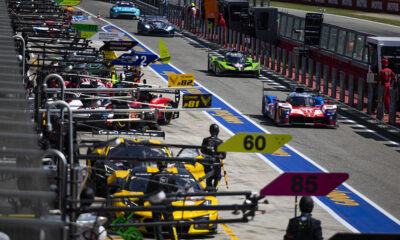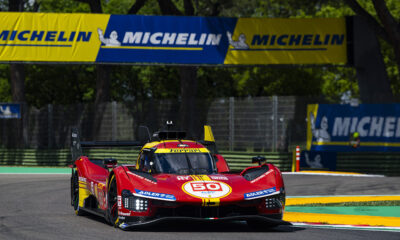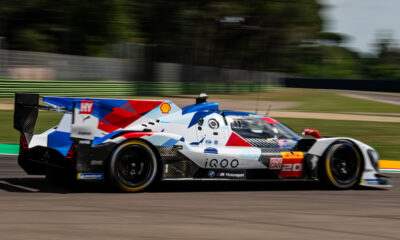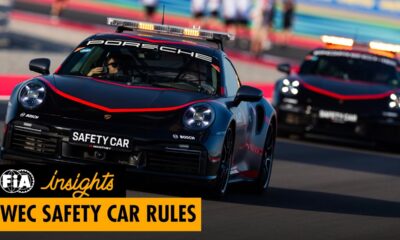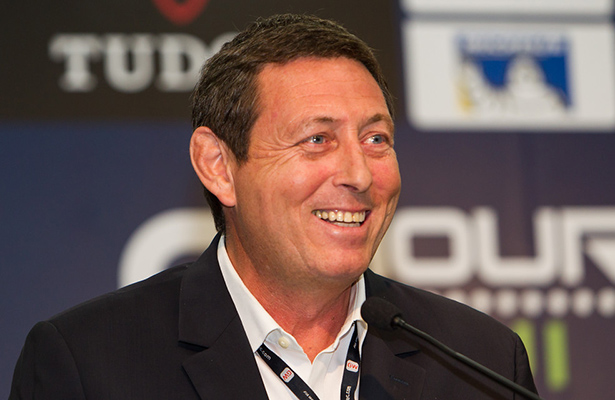
Photo: Adrenal Media/FIA WEC
Gerard Neveu has been the CEO of the FIA World Endurance Championship since its inception. The charismatic Frenchman, who grew up around Paul Ricard, has played a key part in the sport, including re-opening the Le Castellet circuit at a time when few people believed in its potential. (En Français)
Since 2012, he’s directed the WEC alongside ACO President Pierre Fillon. The duo have helped elevate sports car racing to new levels, thanks to the championship’s global reach and increased manufacturer participation.
Neveu is the focus of the latest “Behind the Title” feature, which explores the rise of key executives within the sports car racing industry.
Being from Southeastern France, Paul Ricard was the perfect place to satisfy your passion for motorsport?
“My favorite sport is rugby, which is normal for Toulon. But I’ve always been passionate about motorsport. Paul Ricard is a monument and I grew up in the shadows of the Castellet plateau pines.
“When I was young, I rode my motorcycle to go to the races. I loved it… I grew up in a motorsport atmosphere. At the age of 18 or 19, I turned to the events. I ‘ve always been fascinated by big events.
“For example, I had the chance to work for the World Cup in the French Organizing Committee in 1998.”
You held several positions at Paul Ricard…
“Before having responsibilities at the circuit, I held various other positions. In the ’80s, I did a lot of odd jobs. I was the track speaker at the circuit for the Formula One race. I was the presenter on Radio Vitamine and I supported the animation of the Grand Prix on the radio.
“Previously, I was a volunteer firefighter. For the record, I intervened on Jochen Mass’ spectacular crash in Signes curve, where I was the first one on-site. This is something that I [vividly] remember.”
The circuit became a special place…
“Initially the circuit was only a laboratory that was used for test sessions. We were then a very small group and that adventure lasted 11 years.
“I was one of the people who thought that if the circuit remained only a test track, the legend would become extinct over time. Paul Ricard had some of the finest [moments] in not only motorsport but also motorcycle. I met some fascinating and endearing people.
“François Chevalier is an unusual and rare person. [Philippe] Gurdjian taught me a lot and Claude Sage was also part of my passage.
“The professional world of motorsport is made up of very nice meetings. Over time and discussions, the circuit was reopened to competition with a Ferrari Challenge race being the first event held there.
“I immediately thought it could work despite the misgivings of my board. Then with the arrival of Claude Sage, we had the means to enable the reopening to the public.
“We can now see that it works pretty well considering the quality of the championships that run at Paul Ricard.”
Do you think French motorsport has a future?
“There are many ways to see it. The FIA WEC has gained importance since 2012. The LMP1 regulations established by the ACO and FIA is the best platform for development and innovation.
“Four of the six largest global manufacturers are in endurance. On one side we have the best technological laboratory for the future and the national media in France are cautious about motorsports in general.
“We clearly see the difference with other countries. There’s a real difficulty to have visibility while endurance is a leader in sport.
“Michelin is very involved in endurance, the French drivers are among the best in the world and let’s not forget the best LMP2 manufacturers are also French, with the Le Mans 24 Hours, the organization of the FIA WEC and ELMS being French and the FIA’s offices are in Paris and its Chairman is French.
“The official language of motorsport is French. It’s still quite a paradox. And for all the right reasons, motorsport deserves better media space in France.”
The car is not dead?
“The automobile is and will remain for many years as the main method of transportation for humanity. Motorsport helps drive research and development for the car of tomorrow.
“This is the case of the various World Championships. Everything is going in a good direction. For us [the idea is to have] attractive events that touch the new generation.
“The FIA WEC and Formula E are innovative championships that run regularly in Europe and it’s no coincidence that we share some of the same drivers.”
Is there one particular moment that’s marked your career in motorsport?
“There are many defining moments. Experiencing my first Formula One GP at Paul Ricard and my first 24 Hours of Le Mans were both very strong, as well as the final of the FIFA World Cup. It’s intense in both directions: joy and tragedy.
“Endurance, it’s about the brilliant people you meet because there’s a real human adventure. Sharing the adventure of the FIA WEC with Pierre Fillon is something very strong. There are a multitude of extraordinary people, such as Dr. Wolfgang Ullrich, Mathias Mueller (Porsche), as well as Jean Todt or Sir Lindsay Owen-Jones.
“I have the honor to lead such a great team in the LMEM. I have great admiration for all of my colleagues. It’s important not to forget the drivers who are brave and have incredible generosity. They risk their lives in every race. What sport requires that kind of sacrifice?
“And then there’s all of our passionate volunteers who give the best of themselves… What a wonderful energy.
“One memory was an edition of the 24 Hours of Le Mans where I was in the ORECA box. It was midnight and the car was badly damaged. In just 45 minutes, it was repaired. Then I see two mechanics quietly disappear behind a column of tires at the rear of the garage to cry. They went beyond the emotional and physical limits. That’s stamina!”
Endurance racing is no longer a retirement home for drivers…
“There was an incredible generation in Formula One at the time of Prost, Senna, Tyrell, Head, Williams, Dennis or Ecclestone, etc. Today, we have an exceptional generation in endurance.
“When we see legends such as Jacky Ickx and Henri Pescarolo roll up their sleeves in the FIA WEC, that warms the heart. At Fuji, Henri was like a kid.
“We were very touched by the words of Jacky Ickx to Pierre Fillon on the starting grid at the Six Hours of Spa. ‘We find links to endurance that one hardly sees in other paddocks.'”
Were there any fears with the launch of the FIA WEC in 2012?
“At Sebring, we were delighted to be there. It took [some time] to overcome the sudden departure of Peugeot. The moment was painful for the drivers and the technical team that had given so much to produce a good car for the coming season.
“For all the teams, the FIA, ACO and LMEM, to be at Sebring was a dream that we had in mind and it became a reality. Three years later, the satisfaction is still there.
“Our involvement is [paramount] because you have to anticipate the future. In 2012, we had to build. Since then, teams have grown.
“When we started the championship, the permanent team consisted of 10 people and 60 people at the races. Now there are 30 people working daily and almost 150 for the organization of the events.
“Every day, there are doubts and every day there are certainties. We must respect the paddock because we know that we live in an extraordinary and usual life.”



















